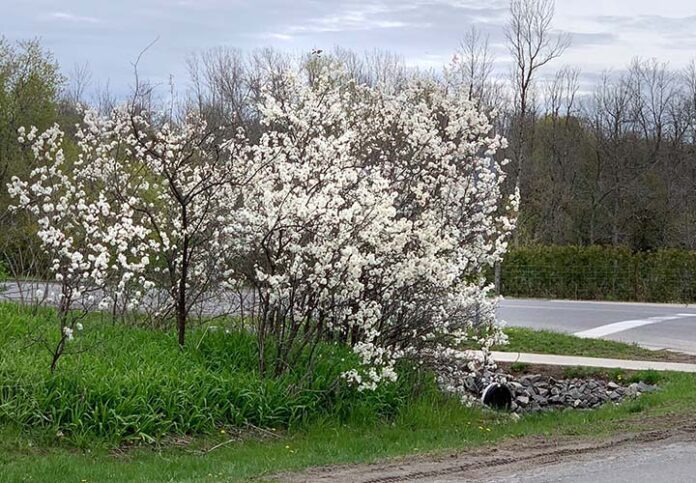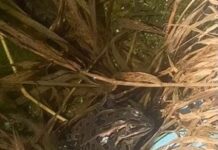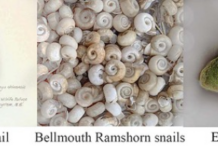by Fred Schueler & Aleta Karstad,
Fragile Inheritance Natural History
It has recently been in the news that the Japanese have been recording the date of blooming of a cherry species, Prunus jamasakura, since 812 AD, and that this year’s peak bloom, on 26 March, was the earliest ever recorded. Cherry bloom is a national festival in Japan, and the progress of the flowering across the country is both reported in the news, and predicted by meteorological formulae.
There are places in North Grenville that are blessed by a similar profusion of bloom on our native Canada Plum, Prunus nigra. One of the most conspicuous stands is the small thicket at the intersection of Clothier Street and Somerville Road in Kemptville. We’ve been recording the date of first bloom in the Canada Plum thicket on our land along Buker Road in Bishops Mills since 1998, with dates which range over a whole month from 18 May in 2003 to 17 April in the pre-polar vortex spring of 2012. This year there were a few blooms open, among lumps of snow on the twigs, on 21 April, full bloom was 24 April, and the snow storm of 30 April pulled a lot of the petals off, before it looked like many pollinators had gotten to the flowers.
For many species, the activity of pollinators would determine the amount of fruit set, but with the Canada Plums in Grenville County, the major determining factor is a fungus, a species of Taphrina, and in most years in place of fruits, the bushes bear hollow, spore-dispersing, bladder-like growths, a disease called “plum pockets.” In most years, no successful sexual reproduction results from the spectacular display of white bloom that covers the bushes before the leaves emerge, and many who have Canada Plums on their land don’t know that the bushes, or small trees, are Plums. In 1999, 2011, 2013, and 2019 our bushes have borne a modest crop of plums, though many of the fruit were dotted by black fungus-spots, and in some sap oozes out into sugary crystals on the surface.
On our land, the fungus also stunts the young shoots, and the blackened Plum Pockets are retained on the twigs over the winter into the next spring’s blooming. We’ve surveyed roadside Plums across North Grenville, but haven’t found any stands free from the fungus, though we did transplant one shoot a few hundred metres from the existing stand, and for several years it was free of Taphrina.
One significance of this disease is that while the invasive Cathartic Buckthorn, Rhamnus cathartica, the dark shrub that lines Bolton and many other roads, is morphologically and ecologically very similar to Canada Plum, it freely produces its bitter fruit, which are dispersed by Robins, Waxwings, and other fruit-eating Birds. Plums spread by suckering, while Buckthorn doesn’t, so it’s likely that the landscape-wide invasion of the alien Buckthorn is partly due to the disease that suppresses the spread of the native Plums, which would otherwise compete with them for the wirey dark shrub niche in eastern Ontario’s oldfields and roadsides. Like Buckthorn, Canada Plum bushes have incredibly twisted sharp twigs, which make the stands very hard to get through, and pushing through a stand after plums is a good way to rip your clothes, get bloody scratches on your arms, and have your glasses pulled off your head and bent out of shape.
When there’s a year when there are plums, and you manage to gather some, you can ferment them in brine, as is done with the Japanese Umiboshi Plums (Prunus mume). The jar of wild plums that we put into brine in August of 2013 is still alive and resisting invasion by moulds in 2021. This culture is a real treasure! We take out the flat, sharp-ended pits, and use the salty, cherry-flavoured flesh in salads and in sandwiches with cheese. We buy bottles of “Umeboshi Vinegar” for salting our soups and salads, and these soft little plums taste just like that, but with an even fruitier flavour.
There’s another similar native species of plum, Prunus americana, which is widely cultivated as hybrids with other species, and doesn’t suffer from Taphrina. It differs most obviously in having sharp, glandless teeth on the leaf margins rather than the blunt, gland-tipped teeth of Canada Plum leaves. Recommendations for control of Taphrina on domestic plums are mostly to spray a lime-sulphur mixture or other fungicides on the trees before the buds open in the spring, and to remove diseased fruit early in their development, but there are differences between what we see on Canada Plum and the development of Taphrina on cultivated plums. We haven’t found any indication that the Taphrina isn’t a native species; we have tried to get tree disease specialists interested in this situation, but so far without success.
In years when our bushes have produced fruit, we have seen some new Canada Plum bushes clearly grown from seeds on our land, so if you want to encourage the species for the spectacle of bloom or the hope of fruit, you can plant the pits, or you can transplant suckers, washing them off before planting in the hope of not transmitting the fungus.










First blooms for 2022 on 5 May in Bishops Mills.
First blooms for 2023 on 29 April in Bishops Mills